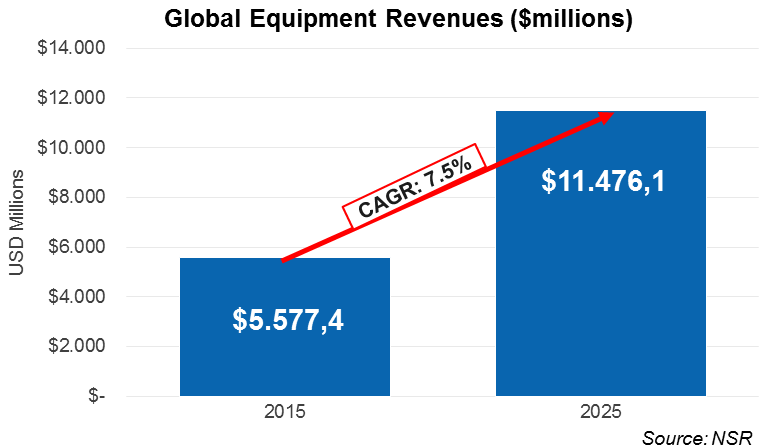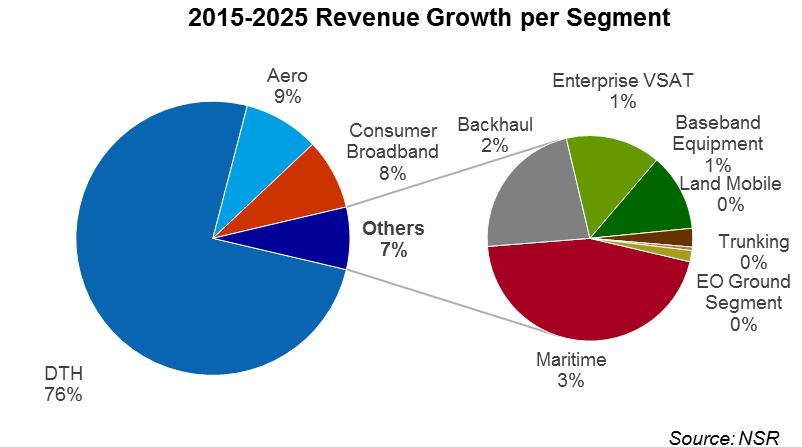Keep Your Feet on the
Ground
Aug 10th, 2016
by Lluc
Palerm-Serra, NSR
Satellites are the stars in the satellite
industry ecosystem. They have attracted most of the
innovative focus in recent years with the HTS or EO
constellation revolutions. However, we must be very
aware there isn’t any satellite value without a
ground terminal. As an industry, we must keep our
feet on the ground and acknowledge that ground
equipment needs to keep pace with the innovation
happening in the skies. The future applications
creating growth for the industry will only
materialize if these technological progresses in the
ground segment take shape. The good news is, the
market opportunity for ground equipment is massive.
In NSR’s Commercial Satellite Ground Segment report,
global shipments for Commercial Satellite Ground
Equipment are forecast to surpass 57 million units
by 2025, generating US$11.5 billion in revenues.

In order to capture a slice of these rapidly
growing but contested market, equipment
manufacturers will need to adapt to the new
technological environment. In video markets, the
transition to HD, Ultra-HD and smart STBs will
generate most of the growth potential. On the other
hand, HTS will be the key driving force in data
markets, opening new market opportunities while
setting new technological requirements. But
what are the key
verticals attracting growth in this market
generating over $100 Billion in Cumulative Revenue
through 2025?
DTH and Consumer
Broadband are the only two truly mass markets for
the SatCom industry. These are the only verticals
counting global annual shipments in millions and
will attract a large chunk of the revenue growth
opportunities in ground equipment. Conversely,
highly specialized verticals like aeronautical and
maritime connectivity together with mobile backhaul
will generate a relatively small number of
shipments, but the high value associated to each
terminal and the rapid development of the verticals
will translate into a significant percentage in the
total revenue growth.

Mass Markets
Driving Growth
The market for
DTH receivers
clearly drives the majority of shipments, generating
$64 billion in cumulative revenues in the next 10
years.
However, there are differentiated trends depending
on each region. In saturated markets such as North
America or Eastern Europe, most of the shipments
will come from upgrades given the end-user
requirements for higher quality UHD and advanced
features resembling the convenience of OTT. On the
contrary, penetration in less developed markets like
Asia or Latin America is still relatively small, and
there is room to engage new customers. The focus in
these regions is still in SD slowly transitioning to
HD.
Consumer
Broadband is the second largest segment in annual
shipments.
The addressable market is massive and the
opportunity to capture new users globally is
tremendous. The challenges lie in serving these
unconnected users economically. Despite the rapid
development of the vertical, the pressure on the
cost of the terminal and finding a compelling
business model are key aspects that need to be
solved.
It is not strange that some industry players push
to develop other mass markets such as the connected
car or the Internet of Things. If these markets were
unlocked, it would bring generous growth
opportunities for both ground equipment and service
provisioning. However, given the technological
challenges and the pressure from ground networks,
NSR is
still cautious about these developments.
Connected
Everywhere
The need to keep connected
everywhere is a major driver for the satellite
industry today, and ground equipment is no
different. Lower price of capacity is opening new
markets and ground platforms should adapt to this
new environment.
Aeronautical
connectivity is among the most interesting verticals
for equipment manufacturers.
In-Flight connectivity is becoming the norm, but
penetration is still relatively small providing very
fast growth opportunities in the near future. Key
players in the vertical are reporting record
installations each quarter, with each terminal
driving several orders of magnitude more value than
equipment in other verticals. Maritime also presents
positive growth prospects. While the
narrowband market is fairly established and
continues to provide stable opportunities, the
emergence of broadband for merchant shipping and
especially for passenger fleets will drive
revenue growth
for maritime equipment at 6.7% CAGR
in the next 10 years. While small in relative terms,
backhaul
is the fastest growing vertical for equipment
revenues
forecasting growth at 15.3% CAGR.
The positive growth prospects shouldn’t be
confused with an easy market environment.
Growth
opportunities will be highly competed, and each
vertical presents its own challenges.
The aviation market has severe barriers to entry,
and terminal requirements are very stringent.
Equipment in the maritime markets needs to meet
higher bandwidth requirements while still facing the
traditional challenges of operating in a harsh
environment. The backhaul market is highly
contested, and the SatCom industry needs to adapt to
meet the technology and business model requirements
of the mobile ecosystem.
Bottom Line
Generating over $100
Billion in cumulative revenues in the next 10 years,
it is clear the opportunities in the ground
equipment markets are quite meaningful. Beyond that,
technological developments in the ground segment
hold the key to unlocking new markets for the SatCom
industry.
The massive demand generated by consumer oriented
markets such as DTH units or Consumer Broadband
terminals, together with high value verticals like
aeronautical, maritime and backhaul, hold the
largest growth opportunities. Other verticals like
SatCom Earth Stations will present some challenges,
but the players that navigate those challenges could
still witness growth.
Optimistic forecasts should not hide the
challenges that industry actors will face. HTS is
creating a whole new set of technology requirements
in terms of throughput, number of carriers, larger
bandwidth per carrier... In an increasingly complex
market, business models and partnerships will play a
role as important as technology. Finally, we must
not forget how the SatCom industry integrates in the
global IP world meeting the new trends in traffic
patterns, media or the emergence of new
applications.